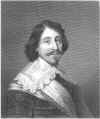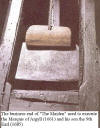|
Archibald Campbell, Eighth Earl, First and last Marquis of Argyll. ( 1607 – 1661 )
Much can be written of the
Clan Campbell and its leaders throughout the history of Scotland.
Archibald Campbell, Marquis of Argyll , was no different from his
ancestors in always seeking to extend his lands and influence.

Known as Gillespie Grumach,
the Grim, and Glied or squinting Marquis, he for a time held supreme power
in Scotland. It was not therefore a total surprise that he became a
leading Covenanter and also the rival and opponent of the Marquis of
Montrose.
In 1633 Argyll handed to
King Charles I the Justiciarship of Scotland, that is all except his own
lands, and was made Marquis in 1641. Following the National Covenant in
1638 there was a breathing space wherein the King was unable to raise a
serious force of arms and he sent the Duke of Hamilton north as the King`s
Commissioner to parlay. “ Flatter them with what hopes you please “
were the Kings instructions but ` dont call them traitors until the fleet
was ready to sail` was the underlying theme. In the event Hamilton had to
allow a General Assembly to be called which he perceived as
unrepresentative of the people and called for its dissolution. When he was
shouted down Hamilton walked out followed by all but one of the Privy
Councillors present – the Earl of Argyll remained and declared “ I take
you for members of lawful Assembly “. The Assembly, now openly illegal,
proceeded to excommunicate the bishops and purged the Kirk of ceremonies,
of the Five Articles of Perth, the Canons of 1636 and the Prayer Book of
1637.
With the support of Argyll
the Covenanters had gained a wily politician who was also able to call
upon some 5000 clansmen if required. Said to have been a man of deep
religious conviction and personal power he was daring in his political
decisions. He had much moral courage but was not a soldier and this
he soon displayed against the brilliant generalship of Montrose. Before
then, however, there were the Bishops Wars
in which Argyll worked diligently for the purification of the Kirk – and
Clan Campbell aggrandisement. For about six weeks
 he he
engaged in a private war in the Braes of Mar, settled old scores with the
Murrays of Atholl; attacked Angus and Rannoch before he moved on in August
to secure Dumbarton Castle against a threat from Ireland.
In 1644, when Montrose
changed loyalties and joined with Alastair MacDonald, or MacColla, Argyll
was to suffer military defeat and humiliation on three occasions. In his
own self interest Argyll was vindictive and victorious , attacking the
Ogilvys of Airlie ( kinsmen of Montrose) looting and burning their houses
at Forther and Airlie. Montrose firstly made a revenge attack on Castle
Campbell in the Ochils above Dollar and set it on afire. On 2 Feb 1645 the
Campbells were again caught and some 1500 slaughtered at Inverlochy ; and
thirdly at Kilsyth on 15 August . After these battles the military
strength of the Campbells would never be the same but it did not stop
Argyll from slaughtering his enemies.
After Montrose`s downfall
and execution Argyll sent the armies of the Covenant to deal with old
family enemies, the MacDonalds of Kintyre and the MacDougalls of Dunolly.
This saw 300 hundred men at the garrison of Dunavertie slaughtered and the
burning of the MacDougall strongholds of Dunolly and Gylen. While in Cowal
the lands of the Lamonts were plundered in revenge for having changed sides – over 200 of that clan were
butchered at Dunoon.
By December 1647 a treaty
known as `The Engagement` was concluded between
the moderate wing of the Covenanters and King Charles I, But it was a
short lived threat to the English Parliamentary forces under Cromwell who
crushed the Engagement`s army at Preston on 17
August 1648. This left the radical Covenanters to return to power with a
vengeance to what they saw as the true revolution. Meanwhile, Argyll was
able to sup with Cromwell at Moray House in the Canongate, Edinburgh. Six
months later his stance changed again when Charles I was executed,
something he and the staunch Covenanters disagreed with as they had always
respected the king`s person. Within a few days the Scottish parliament
proclaimed Charles` son as King. In England the monarchy was abolished and
power taken up by the republican Commonwealth under Cromwell.
Somewhat unpolitically for
him, Argyll used all his cunning and opportunities to ingratiate himself
with the new King Charles II and established a watchful control over him,
There were even proposals that the King should marry the eldest of
Argyll`s daughters, Lady Anne Campbell. Short of becoming Argyll`s son in
law the King lavished favours on Argyll including written promises to make
him Duke of Argyll and a Knight of the Garter. He was the principal
performer at the Kings` coronation at Scone , placing the crown upon his
head on 1 January 1651.
But it was a waiting game
as Charles saw the promised help from Montrose dissolve in defeat at Bonar
Bridge ( 27 April 1650) and Montrose`s execution on 21 May 1650. Totally
reliant on the Scots and the strict Covenanters at this time Charles was
greatly humiliated by their demands. To his credit he bore the insults to
his father and mother, and demands for repentance and humility, with
considerable grace. But it was only stoking the fires for revenge at the
Restoration in 1660. Meanwhile, Cromwell slaughtered Leslie`s Army of the
Covenant at Dunbar on 3 September 1650 where some
4000 Scots were killed and 10,000 captured. It was the turning point
for the Covenanters with dissension in their own ranks, and a split
that became more bitter as scapegoats were sought for Dunbar. This gave
rise to the Resolutioners (the moderates) and the Protesters (the strict
Covenanters) with the moderates eventually coming out on top. They
unwisely supported King Charles and faced up to Cromwell again. Their
final act of desperation was the ill fated venture into England which met
disaster at Worcester on 3 September 1651.King
Charles II fled ` over the water` bearing a large grudge against the Scots
in general and the Covenanters, including Argyll, in particular.
The Revolution that had
begun in 1637 under the leadership of the nobles ended with them uncertain
of where they stood. The fate of Argyll was fairly typical, he had held
the reins of power for twelve years and had placed the crown on Charles II
head in 1651, but otherwise he feared the threat of Crowell and invasion
of his lands – the very threat that had induced him into politics in 1639.
Thus for the next ten years Argyll wisely kept his head down and
collaborated with Cromwell.
Following the death of
Cromwell and the collapse of his son Richard`s attempt at government there
followed the Restoration of Charles who was joyfully proclaimed King of
all three kingdoms in Edinburgh on 14 May 1660 although he arrived in
London on 29 May, his thirtieth birthday. There soon followed the search
for scapegoats with Argyll and James Guthrie the Covenanter minister of
Greyfriars Kirk, soon to suffer execution. Argyll meanwhile travelled to
London to congratulate the new King, despite warnings not to do so, and
was promptly thrown into the Tower of London. After months of lingering in
chains he was sent back to Scotland in December to stand trial in
Edinburgh.
 Argyll`s Argyll`s
fate was seemingly a foregone conclusion, the judges and advocates clearly
understood the King`s wishes. Despite all sorts of obstacles put in his
way – the leading lawyers of the day were threatened and bullied so none
would take up his defence, Argyll acquitted himself well in the months of
interrogation ahead. However, in May the former General Monck, now the
Duke of Albemarle, sent old letters to Argyll which showed that he had
collaborated with Cromwell ( to whom he had given his word of honour) and
his fate was sealed.
The sentence was soon
passed, Argyll having to kneel to hear the ominous words :
“That
Archibald Campbell, Marquis of Argyll, is found guilty of high treason and
is adjudged to be execute to the death as a traitor, his head to be
severed from his body at the Cross of Edinburgh, upon Monday the twenty
seventh instant, and to be affixed in the same place where the Marquis of
Montrose`s head was formerly “
So it was on the appointed
day at 2 pm the Marquis of Argyll said his goodbye`s saying “ I could die
like a Roman but I choose rather to die like a Christian “ . After
speaking to James Guthrie, who was to follow him within a week, he went to
the
Maiden ( as the Scottish guillotine was called *) , made a short speech,
knelt down and gave the signal for the blade to fall. His body was
dismembered according to practice although his remains were later gathered
together and buried in the family vault at Kilmun, Argyll. A mausoleum /
memorial is in St Giles Cathedral, Edinburgh – just across the aisle from
his one time enemy the Marquis of Montrose.
His head was authorised to be taken down on 7 June 1664 and a receipt duly given ( from the records of the Edinburgh Tolbooth, The Book of Old Edinburgh Club vol V p 116)

* The forerunner of the `maiden`was the
Halifax Gibbet used between 1286 and 1650 in the Yorkshire wool town.
The penalty for theft was execution in those days. It consisted of two 15ft uprights,
suspended between which was a heavy metal axe on a lead filled cross- beam,
controlled by ropes and pulley. Halifax records show at least 53 executed
using it. It was brought to Scotland ca the mid sixteenth century. The
French adopted it ca 1789, and Dr Anton Louise (not Mssr Guillotine
whose original proposal was rejected)
invented the diagonal blade which improved the cutting motion. in 1792.
Source: The Book of General Ignorance, S Fry.
18/07/2011
|